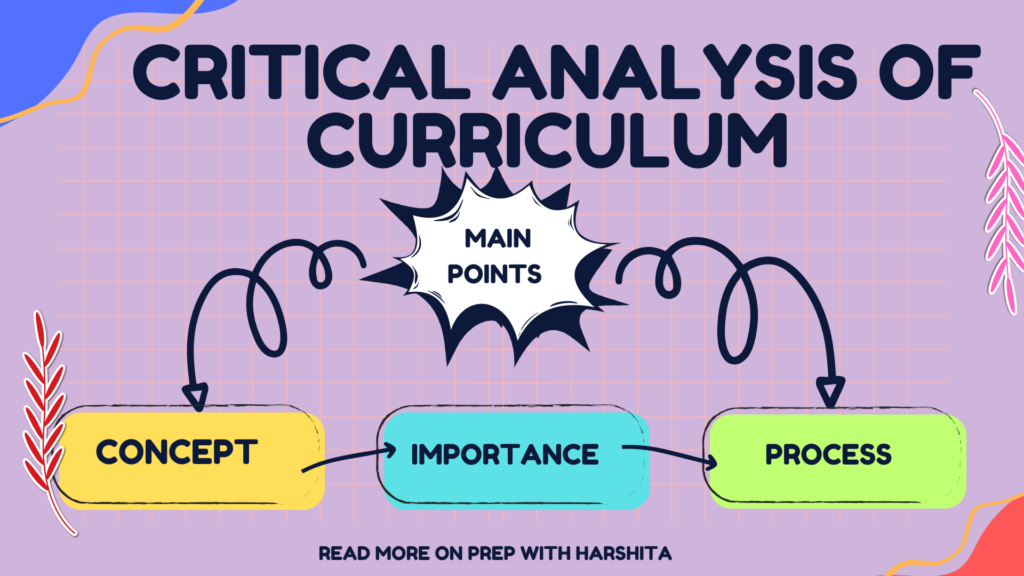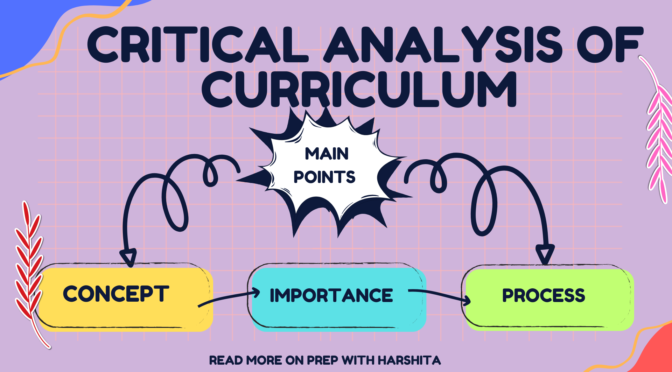Critical analysis of curriculum is a process of evaluating the effectiveness of a curriculum in achieving its intended learning outcomes.
It involves reviewing the curriculum documents, such as syllabi and textbooks, and examining the content, instructional methods, and assessments used to facilitate learning.
The purpose of critical analysis is to identify areas of strength and weakness in the curriculum and make necessary changes to improve student learning outcomes. Critical analysis of curriculum also involves gathering feedback from students, teachers, and other stakeholders to assess their perceptions of the curriculum and to ensure that it is relevant and appropriate for the needs and interests of the learners.
It is an essential process for ensuring that the curriculum remains effective, relevant, and responsive to the changing needs of students and society.
Importance of critical analysis of Curriculum
Critical analysis of curriculum is an essential process that helps educators to evaluate the effectiveness of their curriculum and make necessary changes to improve student learning outcomes. Here are some reasons why critical analysis of curriculum is important:
- Ensuring relevance: It helps to ensure that the curriculum remains relevant to the needs of students and society. By regularly evaluating the curriculum, educators can identify emerging trends and changing needs and make appropriate changes to the curriculum to ensure that it remains relevant.
- Enhancing coherence: It helps to ensure that the curriculum is well-organized and coherent. By identifying gaps and inconsistencies in the curriculum, educators can make necessary revisions to improve the alignment of learning objectives and ensure that students have a clear and logical progression of learning experiences.
- Improving student outcomes: Critical analysis helps to improve student learning outcomes by identifying areas of weakness in the curriculum and making necessary changes to improve the quality of instruction and student engagement. This can lead to higher achievement levels and better preparation for college and career readiness.
- Encouraging reflection: Critical analysis of curriculum encourages educators to reflect on their teaching practices and strategies, and to consider new and innovative approaches to instruction. This can lead to greater creativity and engagement in the classroom, as well as improved student learning outcomes.
- Meeting diverse needs: Critical analysis helps to ensure that the curriculum meets the diverse needs of students, including those with different learning styles, abilities, and backgrounds. By identifying areas of weakness in the curriculum, educators can make necessary changes to improve accessibility and equity for all students.
Process of Critical analysis of Curriculum
The process of critical analysis of curriculum involves a series of steps that help educators to evaluate the effectiveness of their curriculum and make necessary changes to improve student learning outcomes.
Here are some general steps in the process :
- Identify the goals and objectives: The first step in the process is to identify the goals and objectives of the curriculum. This involves reviewing the curriculum documents, such as the syllabus and textbooks, and determining the intended learning outcomes.
- Review the content: The next step is to review the content of the curriculum. This involves examining the sequence of learning experiences, the topics covered, and the depth and breadth of the content.
- Evaluate the instructional methods: The next step is to evaluate the instructional methods used in the curriculum. This includes reviewing the strategies and resources used to facilitate learning, such as textbooks, multimedia materials, and assessments.
- Assess the alignment: The next step is to assess the alignment between the goals and objectives of the curriculum, the content, and the instructional methods used. This involves evaluating the degree to which the curriculum is coherent, relevant, and appropriate for the needs and interests of the students.
- Gather feedback: The next step is to gather feedback from students, teachers, and other stakeholders to assess their perceptions of the curriculum. This can include surveys, interviews, focus groups, and other forms of feedback.
- Analyze the data: The next step is to analyze the data gathered in the previous steps. This involves synthesizing the information to identify patterns and trends, and to determine areas of strength and weakness in the curriculum.
- Develop a plan for improvement: The final step is to develop a plan for improvement based on the findings of the analysis. This may involve making revisions to the content, instructional methods, or assessment strategies, as well as identifying professional development needs for teachers.
Also Visit : Prep with Harshita

Also Read : Curriculum Planning Framework

